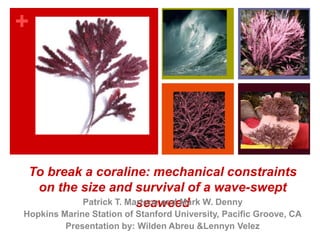
Bio418presentation
- 1. + To break a coraline: mechanical constraints on the size and survival of a wave-swept seaweed Patrick T. Martone and Mark W. Denny Hopkins Marine Station of Stanford University, Pacific Groove, CA Presentation by: Wilden Abreu &Lennyn Velez
- 2. Introduction oCoraline alga Calliarthronthrives in wave-exposed intertidal habitats. oAbility to survive depends on its segmented morphology oCalcified segments, allows for bending, but + produces stress oIntertidalzones of rocky shores can generate water velocities greater than 25ms^-1. (waves) imposing great forces on inhabitants. oDrag is the primary wave-induced force applied to intertidal algae.
- 3. + oCalliarthronthaliare firmly calcified but have flexible When struck by waves, frond joints called genicula, this s bend allows the fronds (thallus) to parallel to its bend when struck by waves. solid surface. oThe average Calliarthronfronds can grow up to 25cm, and can contain Image above 100 genicula, allowing it to demonstrates genicular cells dominate wave-exposed ruptured habitats Calliarthronfronds often break near the base and tend to grow in densely packed clusters. Introduction: Continued
- 4. Methods •Calliarthronfronds were collected from a low intertidal reagion in a moderate wave exposed surge channel at Hopkins Marine Station in Pacific Grove, California. •Stressstrain curves were generated for one geniculum from each of the fronds. Each one was loaded in tension using a tensometer and a video demension analyzer + •Bend to break test •Brndches were removed from each frond by cutting below the first dichotomy, and the rest of the segments were tested by clamping. •The chained segments were girpped by clamps near the first few genicula and held out horizontally. A second clamp was placed near the 10thgenicula and masses were hung in 20 and 50 gram increments until the frond broke.
- 5. + Bend to Break Test http://www.swisseduc.ch/english/maps/ usa/icons/mcalifornia.gif